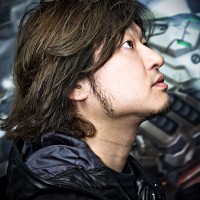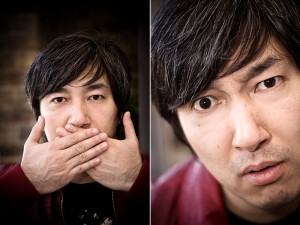
In yesterday’s SA article, I referenced the old axiom “write what you know”. I know Hulk Hogan’s real name (Terry Bollea), I know how to play Street Fighter and I know most of the words to Rapper’s Delight. Sadly, none of these are suitable for a photography blog (a shame, because the words to Rapper’s Delight would definitely fill up a full article). Then I remembered I know about editorial photography, which was the fourth and final thing I know, so I figured I’d tell you about my experiences with editorial, how to get into it and finish with a little shoot report about my very first editorial shoot.
Editorial photography, essentially, is photography which accompanies an article or story of some kind to assist in illustrating and bringing life to that story. In short, it’s pretty pictures to look at whilst you read. Editorial is great because those are the only criteria you need to class images as editorial photography, so it can suit a wide range of interests. For example, editorial can be in the form of fashion photography, documentary photography, food photography (like in those nice photos of delicious recipes you find in the weekend magazine supplements that you will never actually make) or editorial portraiture accompanying an interview.
Getting Involved
Although editorial is a saturated market, there are a lot of publications around, all with picture editors looking for images to commission. It’s up to you to make yourself known by providing striking, relevant images.
Take a look at your portfolio – what sort of images do you take? Where would you fit in? If you spend all your time shooting landscapes, you might want to look at countryside magazines, walking magazines, or even holiday magazines if your landscapes are shot abroad. If you’re a food-tographer (I just made that portmanteau up: horrible, isn’t it?) then you’ll obviously want to be looking at food mags or supplements in weekend newspapers, as mentioned above. It all depends on what you shoot. What is important is that you contact the image editor / art editor of the right publications for your work.
Cut The Cr…iminally out of date work
Be your own harshest critic. Look at your photos, look at the old stuff that doesn’t cut it and replace them with newer, better images. Don’t be sentimental with an old image just because you have a fondness for it – your site should be displaying your best work. I can’t remember where I heard this, so I’m afraid I can’t credit it, but the best single sentence I heard about displaying my work in an online portfolio was “your site is not for you”. Even if there is an image you still like, if it’s not relevant to who you’re trying to attract with your work, or there is one that is technically much stronger, either remove it completely or move it to a different section of the site.
Editorial? Sounds Drier than a Cream Cracker in the Gobi Desert
I beg to differ, my friend. There are many reasons I love editorial photography, but the main reason is the pressure. Depending on the shoot, more often than not you’re given a location, a subject and (if you’re lucky) a general idea of what shots you’re required to take. No two shoots are the same. When you arrive, all number of problems could crop up in a variety of areas. There might be terrible light levels, you may encounter snotty, uncooperative PR (as a disclaimer, I’ve encountered some lovely, lovely PR people, too, who have helped me get some of my favourite editorial shots, so there are some lovely PR types, too).

Keita Takahashi, photographed for GamesTM. I had a whole area cordoned off and fifteen minutes to get what I needed. That's more like it!
Sometimes, you’ll have 20 minutes to get your shots, sometimes you’ll have 20 seconds. Sometimes, your flashgun stops communicating with your camera halfway through a shoot and you have to swear under your breath, tear it off, and quickly adjust your settings (that was a fun shoot). Sometimes, you’ll turn up with half a dozen brilliant ideas that you think will look fantastic in the magazine and the subject says “no, we don’t want to do any of those. Just get some of us looking natural”.
Basically, thinking on your feet and creating something aesthetically pleasing and striking using your surroundings is at the heart of on-location editorial photography. And I love it. The satisfaction of solving the photographic puzzle laid out in front of you, and the resulting positive feedback, is one of the main reasons I quit my 9 to 5 and became a full-time freelancer.
Editorial isn’t for everyone, and it can be very hard to break into, but if you’re keen on it just get your work out there: contact picture editors with your stuff and, if it appeals to them (and they don’t already have two dozen photographers already working for them), they might just give you a shot. My main magazine work came simply from me finding out who the photo editor was, sending an email with a link to my online portfolio and, well, that was it. Aim for local magazines, too – people who publish around your area. It might not pay at first, but it’ll look good on your portfolio and, in my opinion, nothing gives you a bigger buzz than seeing your own work published.
Once Upon a Time, in a Fancy London Office…
Here’s a little story about my first ever editorial commission. GamesTM magazine, a regular client of mine, asked me to accompany a journalist to procure interview and posed portraiture shots of a videogame designer who was visiting from Japan. This would be Goichi Suda – the critically acclaimed and much loved head of Grasshopper Manufacture, one of my favourite companies. So far, we have two stress factors to add to the mix: first editorial ever? Check. Photographing someone who, in my nerdy world, is essentially a celebrity (and a hero of mine)? Check.
We turn up to the fancy London office, only to discover that Suda-san has literally just arrived by alternative flight, Eurostar then underground train, because his original flight was cancelled. He was meant to arrive the day before. Understandably, he’s not that keen on having his photo taken, seeing as he’s not had any sleep for many, many hours. They ask if I can return tomorrow. I’m more than happy to do that and I just sit in on the interview. The thing is, I’ll be returning tomorrow on my own, essentially representing GamesTM. That’s stress factor number three. They warn me that they’ll have to fit me in between two scheduled interviews, so I’ll probably only get fifteen minutes (ah! Fifteen minutes seems like luxury these days). Thankfully, I plan ahead and get some test shots done in the room we’ll be using the following day to shoot.
Except the next day, everything’s moved. And we don’t have fifteen minutes, we have about five. Stress factor number four. I’m not blaming the lovely PR people for that, because they were on an extremely tight schedule and it was kind of them to let me back the next day at all. But five minutes for your first editorial shoot is unbelievably stressful. Did I mention that Suda-san doesn’t really speak any English, apart from “nice to meet you” and “I like your t-shirt” (I had a cool tshirt on, because I’m dead cool and that)?
So now I have five minutes to make sure I get the kind of shots that are good enough to ensure that GamesTM like them enough to ask me back and become a regular customer. In a room I didn’t plan for. I also have to direct my subject through a translator. “Baptism of fire” doesn’t even begin to cover it.
The thing is, I thrived under the pressure: we created a series of fun headshots with a range of expressions that were meant to represent the different sides of Suda51 – his dedication to his artistic vision and his role as a businessman who needs to make sure his work has a broad enough appeal to sell. This is the sort of stuff I would take in my stride these days but, at the time, I felt like my head was going to pop. The payoff, though, when the magazine used about a dozen of the images, turning it into a multi-page article, was more than worth the pressure at the time.
I Suppose I Should Round this up, Then.
I think everyone should have a go at editorial photography in some way. It is possible to create work with an editorial feel without waiting for a commission. Create a series of images that tell a story, similar to a mini project. If you get into the habit of telling a story with your images, regardless of your subject matter, it will help you get more out of your photos and take them to the next level.







